Please click on the link above for my holiday greeting to CONE Welder users. Hope you enjoy it!
–idbirds–
Please click on the link above for my holiday greeting to CONE Welder users. Hope you enjoy it!
–idbirds–
Several of us have been active participants in CONE Welder for many months. We’ve developed a few guidelines that help us get along with each other, and allow everyone to take good pictures.
Be aware that there is only one camera, and it is shared by everyone who is currently logged in (left side of Chat screen). If several people try to drive the camera at the same time, no one gets a decent picture, and everyone gets frustrated.
The first guideline is: Only one camera driver at a time.
How do you know if someone is driving? If the camera lens (on the right side of your screen) is moving over the landscape, or around some feeder, then someone else is driving. If it is not moving, then the current driver may be waiting for the camera to move (sluggish internet connection), may be waiting for the return of something that just jumped off-screen, or may wish someone else would take over.
What if you want to drive the camera? Keep the Chat window open – you don’t have to participate in conversations unless you want to. If you want to drive the camera, on the Chat screen ask: “May I take the camera?” Abbreviated to MITC? Then wait 30 seconds. Someone will let you know if they really need to continue. Otherwise, you are free to take the camera.
The second guideline is: Ask first; don’t just grab the camera.
When you are finished driving the camera: Use the Chat function to announce “Camera is free.” Abbreviated to CIF.
So now you’ve taken a picture, what next? For those pictures worth keeping, try to zone your pictures promptly. If the picture contains images that are so small or fuzzy that they cannot readily be identified by others, it may be appropriate to delete the picture. It you keep such a picture, it’s considerate to add a note to the comment section indicating the classification you have assigned. Otherwise the picture may languish forever in the Unclassified files. If you are unsure about the correct identification, use the Chat function to ask others for assistance. If you have two or more species in one picture, zone each species separately. If you have two or more of the same species in one picture, you may zone them together or separately. [If you zone them separately, you get more points – a boon to the more competitive among us, and an annoyance to everyone else!] Zone separately any bird that has a band or other unique characteristic. The system gives you an hour from the time you take the picture until the picture appears on the “public” screen. It is best to get your picture zoned before it becomes public.
There are unzoned pictures on the public screen. Should I zone them? No. Sometimes photographers keep several pictures for a while – trying to decide which to delete. If you put a zone, comment, or star on that picture, the picture can no longer be deleted. When looking at those pictures, try to keep your hands off the keyboard! It’s okay, though, to use the Chat function to remind the photographer that s/he has unzoned pictures.
The third guideline is: Don’t put zones, comments, or stars on someone else’s unzoned picture.
Can I take a picture of anything? Pretty much, yes. Keep in mind that the Welder study is concerned with range expansion for several traditionally subtropical bird species (see the link for the list on the About page). So it’s good to get pictures of those species when you can. Birds, insects, mammals, reptiles – are all fair game. Occasionally you may also see people. But – just like at home – don’t take pictures of people without their permission: it’s an invasion of their privacy.
Other questions? Use the Chat function to ask. Among the people logged in, there is likely to be someone who will be glad to answer or refer you to a place where you can get an answer.
This morning several CONE players chatted at length about the way our scores went up and down, for no apparent reason. The discussion showed us that many people were experiencing the same yo-yo scores, and that it was incomprehensible to all of us. We agreed that the information about scoring available to us in the Tutorial did not adequately address our questions. Related to that, some of us have read all or part of Bryce Lee’s paper, and are increasingly aware that we do not know the whole story with this “game.” We agreed that I would write to Ken Goldberg and ask for his comments. Our correspondence follows.
10/03/08 8:28am Loughman to Goldberg: There was a lot of discussion on the CONE-Welder Chat this morning (7:31-8:21 am) about scoring for the game. Would greatly appreciate your reading it, sharing with appropriate colleagues, and getting back to me with your comments which we could post on the Blog. Thanks.
10/03/08 9:18am Goldberg to Loughman, with copies to CONE Welder team: Please rest assured that we are definitely not playing mind games with CONE-Welder players:
Over the summer, Yan observed his score going down a few times and we worked really hard to track down a potential bug in the system but found it hard to repeat. Scores can go up when one is offline due to others classifying your photos, but they should never decrease unless in the relatively rare situation where a photo gets re-classified.
We apologize for this bug. We’ll take another look at this and try to fix it. We have utmost respect for our players and always strive to maintain fairness.
10/03/08 9:51am Loughman to Goldberg, with copies to CONE Welder team: Thanks for your quick response. Fixing the bug would certainly alleviate SOME of the angst!
But the other thing we need is for someone to post clear and complete *rules of the game*. Bryce Lee’s paper does seem to indicate that Big Brother is involved. How? As I said in the Chat, that’s creepy!
If we’re better informed, we can make more meaningful contributions.
Your further comments appreciated,
Kay Loughman (user loughman1 in CONE) has been doing some really great work lately posing questions to various experts (as her post on the banded Buff-bellied Hummingbird shows). She and I recently put together a list of questions for the people running the show at CONE Welder, and we’ve now received answers that I want to share with you all. (Dr. Selma Glasscock at Welder indicated that she was going to be out of the office until the second half of August, but indicated she would be happy to forward some responses as well when she gets back.)
Dr. Glasscock (and others),
You had previously indicated it would be okay for users of the CONE Welder system to periodically forward you a list of questions and suggestions we had about the system. Attached is a summary of some of the questions users have submitted lately. Any responses you can pass our way would be great; I’ll post them on the blog I maintain.
Thanks.
John Callender (aka “elanus”)
jbc@jbcsystems.comWELDER
1. Do you have a checklist of Welder’s non-bird wildlife that you could forward to us? Many of us are interested in wildlife beyond birds. A complete list would help us to know more about the area. And in our lax time, we could speculate about the identities of generic frogs, snakes, etc. (loughman1)
John Rappole writes: Selma can correct me if I’m wrong, but I don’t believe that there is a checklist on non-bird wildlife.
2. Beyond the information in the Welder bird checklist regarding the abundance of different species in each seasons, do you have any information you can forward us about what bird species we can expect to start seeing migrating through, and when we might see them? (loughman1)
John Rappole writes: That is a book-length request. Over 300 species of migrants occur in the Texas Coastal Bend region, of which Welder is a part. Over 200 of them have been recorded at Welder. The best source for detailed information on the birds would be a copy of Rappole and Blacklock, 1985, “Birds of the Texas Coastal Bend”, Texas A&M University Press, College Station, Texas or Rappole and Blacklock, 1994, “Birds of Texas”, Texas A&M University Press.
3. The Welder checklist shows Mourning Dove as Common all year. In California they frequent seed feeders, so we’d expect to see them regularly in our area at Welder. But we’ve seen hardly any. Are they elsewhere at the refuge, or simply not as common as we might expect? (loughman1)
John Rappole writes: Mourning Doves are common at Welder all year, as are many other seed-eating species that are not visible regularly at the feeders. Why each of these is or is not at the feeders at any given moment is a study in itself.
4. Do you have any information you can forward us about what bird species have been banded with what colors at the refuge? It is often difficult to determine the band colors. Other than indicating “Banded” in the comments accompanying an image, is there anything else we could do to help identify banded birds? (birdbrain)
John Rappole writes: The only birds that I have banded to date are six Green Jays and a few Inca Doves. Selma and her assistant have banded others, but not in the vicinity of the feeders – and therefore very unlikely to be seen there.
5. Would it be possible for us to know specifically where at Welder the camera is located? We’d like to know more about the habitat beyond the camera’s field of view.
John Rappole writes: The camera is located about 100 meters WNW of the headquarters building, which should be readily visible on Google Earth. The habitat is live oak-mesquite chaparral with some elements of riparian forest. An ox bow lake (Encino Lake) of the Aransas River is about 400 meters north of the site, and the river itself another 500-600 meters beyond that.
6. We very much appreciate the efforts that have been made to immobilize the feeders to minimize movements in the wind. It definitely helps. Even better would be an arrangement of _three_ guy wires running down from each feeder, arranged so that the three wires are in separate planes. By having two guy wires running down from the feeder, diverging to different points on one horizontal wire, and then having a third wire running down from the feeder to a different horizontal wire off to one side, and tensioning all of the wires, you could create a rigid pyramid configuration that would keep the feeder motionless even on windy days. That would be very helpful for aiming and focusing the camera for close-up shots.
John Rappole writes: We have had many suggestions concerning how to improve the feeding site, all of which cost money and time that we do not have a lot of at presesnt. If this project gets solid funding, we will consider what measures need to be taken to best achieve the goals of the research.
WELDER and CONE
7. Would it be possible to add Black-crested Titmouse to the CONE drop-down menu? Although once a subspecies of Tufted Titmouse, Black-crested has been a separate species for some time now, and that is what we believe we are seeing at Welder at least half the time. (loughman1)
John Rappole writes: Although the small hybrid zone for these two forms begins just north of Welder (along the Mission River), and Tufted Titmouse range begins at the San Antonio River, only the Black-crested Titmouse is to be expected at Welder.
Yan Zhang (a member of the CONE team at UC Berkeley) writes: Black-crested Titmouse has been added as a new species.
8. Can the panorama picture be updated to reflect what the site looks like currently? The vegetation and feeder arrangement have changed since the site went live, and it would make navigating the camera easier if the panorama matched the field of view. (loughman1)
Yan Zhang writes: Concerning the panorama, may I request a new panorama image from your side, Dez? Thanks! [Addressed to Prof. Dezhen Song of the Dept. of Computer Science at Texas A&M University, co-developer of CONE.]
CONE
9. We would very much like it if logs of the in-game chat were accessible to users, preferably with date and time stamps. (tinyang)
Yan Zhang writes: We’ll figure out a way to log the chats and make it accessible.
[elanus again] So, there you have it: Some really great responses from some of the people connected with CONE Welder. Thanks to Kay Loughman for putting together the list of questions, and thanks to Dr. Rappole and Yan Zhang for their great answers (and pre-emptive thanks to Dr. Glasscock for her answers when she returns to the refuge).
One of the neat things about CONE Welder is that we have the floodlights at night, and a lot more mammals to look at. I confess I’m not as interested in them as I am in birds, but that’s just personal prejudice, mostly. I’m all about combatting prejudice, so here are some of the more-interesting mammal shots taken lately.
Vanilla got this shot that shows both species of Welder’s wild pigs at the same time: I believe that’s a Javelina on the left, and a Feral Hog on the right:
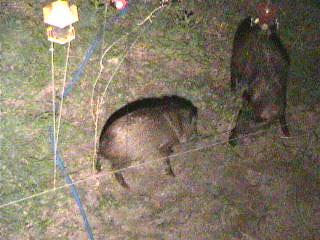
Here’s a shot that achadamaia got of a Nine-banded Armadillo:
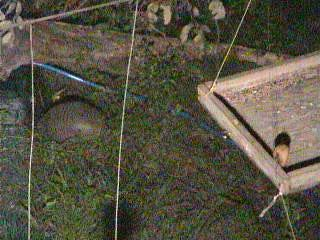
Here are two shots from a larger series taken by vanilla last night showing why it’s important that the feeders are suspended on wires — and why it doesn’t always matter:
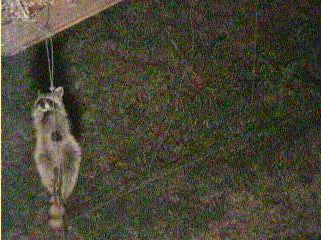
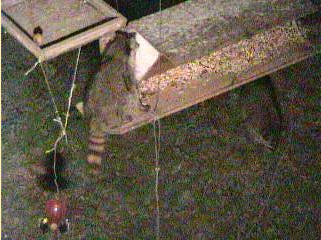
Finally, here are a couple of shots I took this morning. It really looks to me like this White-tail doe is pregnant. How fun would it be to see a new fawn taking its first steps into the meadow? (Cue the Bambi music.)
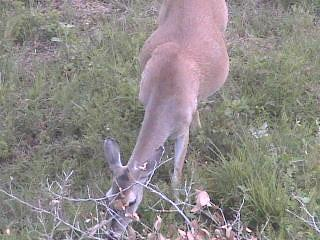
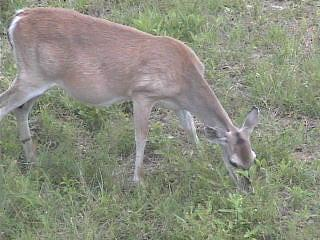
While we wait for CONE Welder, here’s a stroll down memory lane: Craig posted a YouTube video of Roscoe recently, so we can actually hear what our favorite squirrel sounds like. Check it out:
I think that’s right under the birdbath, but the video never goes high enough to show it.
*Sniff* I miss Craig’s deck.
Update: Oops. No, according to Craig it’s the lefthand corner of the deck.
The CONE Welder birdcam isn’t live yet, but it’s never to soon to start obsessing, right? Here are some interesting items I’ve come across lately:
Okay. I’m ready. I’m more than ready. 🙂
I got a little choked up reading all the nice comments people were leaving at this photo taken today by robin54. (And check out the ghostly image of “Casper” left of the T-bar.)
I’m planning to post some retrospective items over the next few days, and I’m certainly planning on reviving posting when the camera goes back up in Texas in March. In the meantime, thanks to everyone for making the CONE Sutro Forest birdcam so much fun.
(Apologies to user vanilla, from whom I stole the idea for the title.)
So, with the fall migration in full swing, things have really been hopping on the birdcam. After a long summer with only the usual suspects to look at, new species are popping up seemingly every day.
Back on October 22 we got the Townsend’s Warbler, and then, on the evening of Saturday, October 27 at 5:02 p.m., avatar99 and annelizabeth combined for three more great shots of it. Here’s my favorite, by annelizabeth:
That would have been exciting enough, but just 10 minutes prior to that, birdbrain and achadamaia snapped a total of six shots of what I’m inclined to think are two Yellow-rumped Warblers. So far all the shots are in disputed status, with none of them particularly close to an ID, but take a look at these three (which I think are the clearest of the bunch), and see what you think:
These images make me think about an interesting aspect of bird-watching via the birdcam, versus doing it in real life. If this were real life, it would be easy to just watch these birds for a few minutes, waiting to see the telltale flash of that yellow rump, or to hear the characteristic Yellow-rumped “chip!” But with the birdcam, all we’ve got is what’s in the shot. Which is actually a good thing, some ways; I’ve definitely honed my ability to ID a House Finch based on an out-of-focus image of just its back, for example, with that characteristic pale edging on the feathers. But it can make things challenging in a situation like this. Like the Orange-crowned Warbler from October 26, we may just have to content ourselves with leaving these birds in “disputed.”
Continuing the theme of birds that are achingly close to being a new species, check out these three disputed shots by kryptonkay and avatar99 (there was also a fourth one by achadamaia, but I’m leaving it out because it’s pretty much identical to kryptonkay’s, only a bit fuzzier). The first shot is from 4:26 p.m. on October 28; the other two are from 4:06 p.m. on October 29:
I think what we’re looking at here is an immature White-crowned Sparrow. The pinkish/yellowish beak is what gives it away; the Golden-crowned’s beak is grayer. I’ve got a ton of these guys at my feeder in the backyard these days, and they sure look like this.
An interesting development is that some goats have been penned on the hillside behind Craig’s house; apparently they’re being used to clear out some of the underbrush in the Interior Greenbelt. Here’s a nice shot taken by none other than cnewmark himself:
Update: More details on Craig’s blog: My pet goats.
Finally, I have to include this shot taken by spurdin. As vanilla pointed out in the comments, “perfect for Halloween!” 🙂